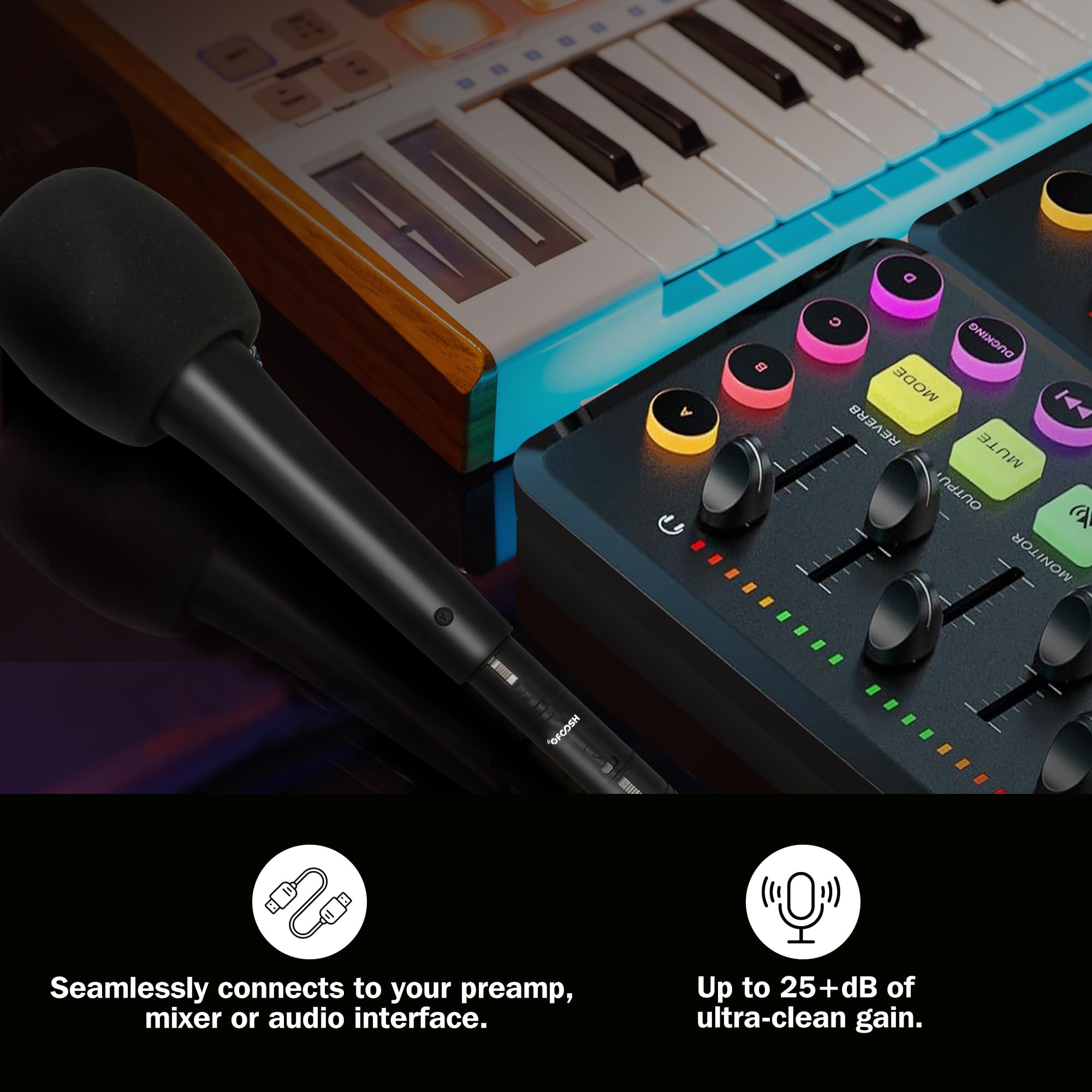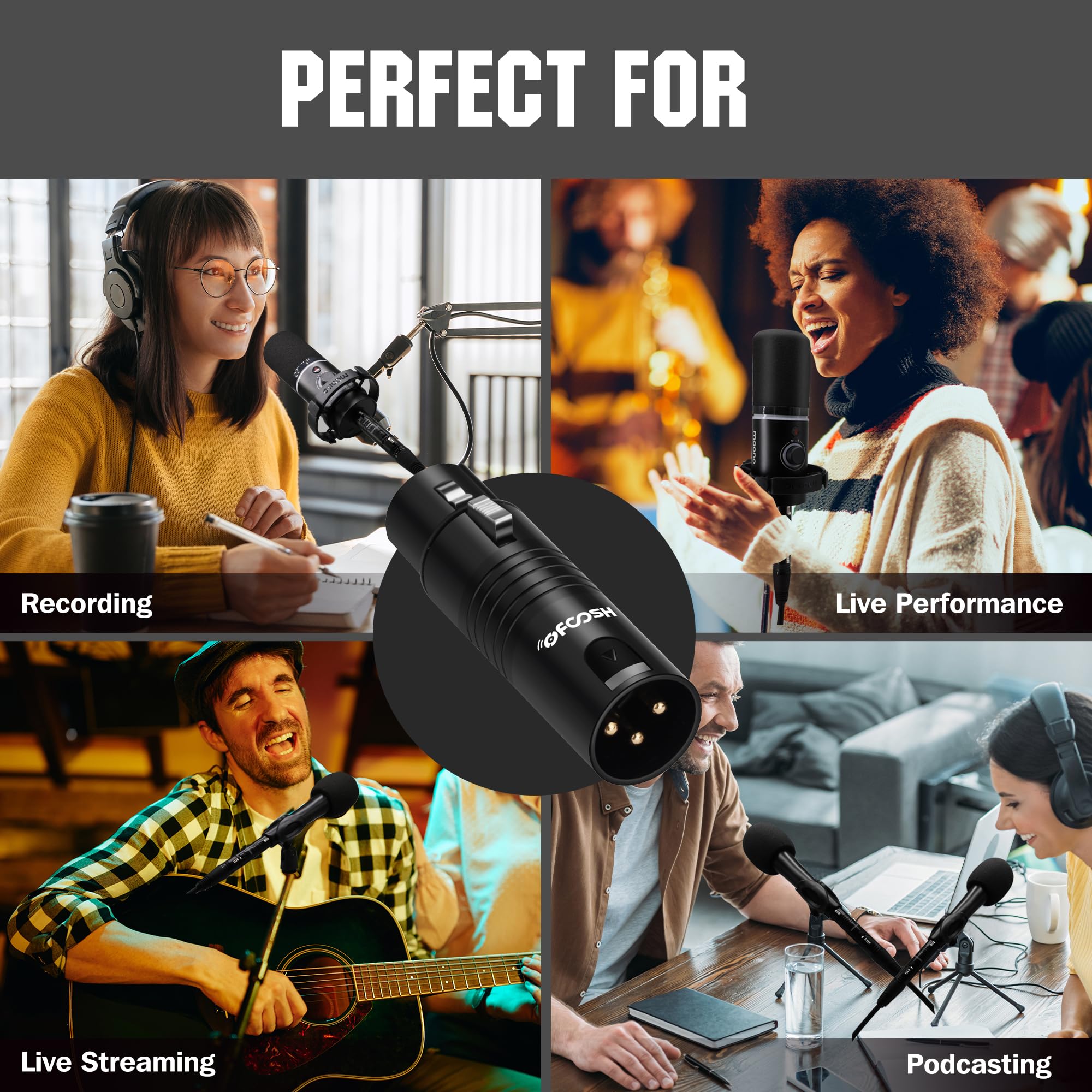Customer Services
Copyright © 2025 Desertcart Holdings Limited
Desert Online General Trading LLC
Dubai, United Arab Emirates









🎶 Elevate Your Audio Game!
The OFCOSH Microphone Preamp Audio Booster is a professional-grade mic activator designed to enhance the signal of quiet audio sources. With a 25dB noise-free gain, it ensures clear amplification without phantom power transfer, making it ideal for dynamic and passive ribbon microphones. Perfect for podcasts, live streaming, and studio recordings, this plug-and-play device is user-friendly and compatible with various microphone types.
| Item Weight | 91 g |
| Product Dimensions | 7.62 x 2.54 x 2.54 cm; 91 g |
| Item model number | OFCOSH-OM-1 |
| Country Produced In | china |
J**T
Worked great for podcast
I've been using the OFCOSH mic preamp for around a month now. I've used it at band practice in a high volume environment with minimal results. And while I could tell that it did in fact boost the signal, it wasn't enough to make a huge difference in over all quality.Where the booster really worked well, in my opinion was in a podcast scenario. I could tell a noticeable difference in the sound quality when it was used with only the spoken word. There was an added volume as well as clarity boost. I was still able to maintain the mid level warmth, whereas some boosters have been known to give a tinny sound to the mix, the OFCOSH did not. So while results may vary depending on use, I am very pleased with the quality and would recommend for use for podcast or a light rock or acoustic music project. Thank you.
C**O
A little pricey, but it definitely gets the job done
This has one simple job -- it boosts the level of the audio signal from a dynamic or ribbon mic that has relatively low output. So it is especially appropriate for a mic like the Shure SM7b, which is notorious for having rather low signal output by itself.Two important things to nnote, though, which I didn't fully understand before I ordered it:You do need to use it on an input that provides phantom power, but it does not send that phantom power to the microphone itself. It uses the phantom power for *itself* to work, but it does not pass it on to the microphone. What that means is a) it will not work with a condenser mic that needs phantom power (unless you use an additional, separate phantom power source between this preamp and the mic, and b) it is safe to use with a ribbon mic that would otherwise be damaged if you sent it phantom power.The signal is clean and it does not appear to add a lot of noise to the signal.It is extremely solid, metal construction, and it is very small for what it does (only about the size of a male to male XLR adapter)
S**
Give it a bump.
I've been playing music for over three decades. I've done my share of shows, and being on the instrument side of recording. Recently (3-4 years ago) I started writing and recording my own stuff.I'm not an audiophile, or perfectionist, but I do have a good ear and try to keep things sounding as good as I possibly can.That said:This little bugger does increase the signal from the dynamic mics I'm using. I have unplugged it, recorded a minute or two, then plugged it in and recorded a minute or two. I do notice a slight difference, but if your vocals are going over music, or the instrument you are recording will be mixed with other tracks, the difference is negligible. I mean, if you have a perfectly sound dampened studio and really nice studio monitors, you might notice a little difference in tone.But, the majority of people that will hear your music will listen on stock car stereos, bluetooth speaker, or earbuds. You will get more tonal differences between two brands of bluetooth speakers than from the preamp.If you're a pro and listen to every track independently through good studio monitors, this might not be for you. If you're a prosumer that loves to write and record, and aren't as worried about slight tonal differences, -or can EQ and mix for them- it is a great little preamp.Not that a stronger signal does my off-key attempt at singing any favors...
D**D
More "Prosumer" than Pro. OK for low-output Dynamic / Ribbon mics
I have been doing audio recording for well over 20 years, microphones being the first thing I learned to use - with Shure dynamic & condenser mics - and a variety of microphone preamps which were mostly pretty terrible compared to the average mic preamp you'll find on even $100 USB audio interfaces today, which are OK. I am explaining this because any professional audio engineers will tell you that obtaining a good microphone signal sound depends on the quality of the preamplifier (aka "preamp") almost as much as the microphone itself. Many budget/portable recording interfaces or mixers have built-in mic preamps which are lacking in the amount of gain (preamplification) and/or +48V phantom power (often as low as 12V) they can provide. Sometimes you don't have a mic-level preamp at all - such as on my Roland MC-909 or Behringer UCA-202 - so I thought this neat little in-line preamp could provide such gain in a pinch but after testing it and thinking it over more, it doesn't make much sense because this device requires +48V phantom power over an XLR cable and I cannot think of a single product I've ever seen / heard of which is capable of providing this but doesn't do preamplification as well (more often you'll get only the preamp, but no phantom power).This can't be used with condenser mics, at least not without a second XLR with +48V phantom and second XLR cable, because condensers require the phantom power and this uses it for preamplification. So then the only cases in which it'd be helpful are if you're using it with a ribbon mic (these are notoriously low output) on an interface/mixer's mic preamp as these often have +48V but only 50 to 55db of gain. Its unlikely you'll get a good sound with an inexpensive ribbon mic, so if you're going to use a ribbon mic I'd suggest getting a dedicated mic preamp. The other situation when it could make sense is if your dynamic mic has got a weirdly low-level output or if you're working with XLR connectors for a stagebox and you need to boost the signal coming from your line-level device (sampler, looper, keyboard, etc)In my brief testing it did not seem to provide 25dB of gain, maybe 18-20dB of gain. Fortunately I wasn't able to notice any degradation to the sound of my singing with an Electrovoice microphone via my RME Babyface preamp/interface.
S**R
Adds plenty of volume
I have some dynamic microphones that are a little low in volume that I wanted to make more use of so I decided to try this out. It definitely does its job, almost too well, so be prepared to keep the volume all the way down when you connect it. Keep in mind that this takes phantom power to work. Only the device takes the +48v and it doesn’t transfer through to the microphone but just be aware that you will need it for this device to do its job. Otherwise, it definitely boosts the volume to a level that would be acceptable in any application needed.
Trustpilot
2 weeks ago
1 week ago